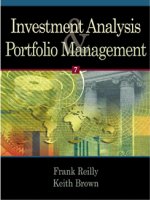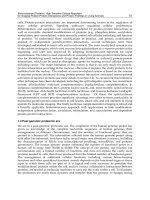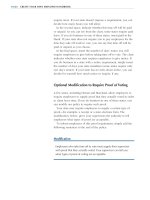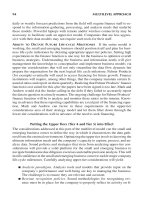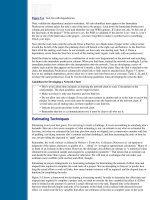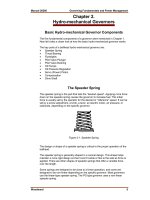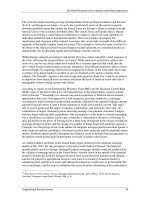advances in Investment Analysis and Portfolio Management phần 5 docx
Bạn đang xem bản rút gọn của tài liệu. Xem và tải ngay bản đầy đủ của tài liệu tại đây (230.48 KB, 16 trang )
Investment Analysis and Portfolio Management
66
weighted average of the Betas of its component securities, where the proportions
invested in the securities are the respective weights.
12. Security Market Line (SML) demonstrates the relationship between the expected
return and Beta. Each security can be described by its specific security market
line, they differ because their Betas are different and reflect different levels of
market risk for these securities.
13. Arbitrage Pricing Theory (APT) states, that the expected rate of return of security
is the linear function from the complex economic factors common to all
securities. There could presumably be an infinitive number of factors. The
examples of possible macroeconomic factors which could be included in using
APT model are GDP growth; an interest rate; an exchange rate; a defaul spread
on corporate bonds, etc.
14. Market efficiency means that the price which investor is paying for financial
asset (stock, bond, other security) fully reflects fair or true information about the
intrinsic value of this specific asset or fairly describe the value of the company –
the issuer of this security. The key term in the concept of the market efficiency is
the information available for investors trading in the market.
15. There are 3 forms of market efficiency under efficient market hypothesis: weak
form of efficiency; semi- strong form of efficiency; strong form of the
efficiency.Under the weak form of efficiency stock prices are assumed to reflect
any information that may be contained in the past history of the stock
prices.Under the semi-strong form of efficiency all publicly available information
is presumed to be reflected in stocks’ prices.The strong form of efficiency which
asserts that stock prices fully reflect all information, including private or inside
information, as well as that which is publicly available.
Key-terms
• Arbitrage
• Arbitrage Pricing Theory
• (APT)
• Coefficient Beta (β)
• Capital Market Line (CML)
• Capital Asset Pricing Model
• (CAPM)
• Efficient frontier
• Efficient set of portfolios
• Expected rate of return of the
portfolio
• Feasible set
• Indifference curves
• Map of Indiference Curves
Investment Analysis and Portfolio Management
67
• Market efficiency
• Markowitz Portfolio Theory
• Market Portfolio
• Nonsatiation
• Portfolio Beta
• Risk aversion
• Risk free rate of return
• Risk of the portfolio
• Security Market Line (SML)
• Systematic risk
• Standard deviation of the
• portfolio
• Semi- strong form of market
• efficiency
• Strong form of market
• efficiency
• Total risk
• Unsystematic (specific) risk
• Weak form of market
efficiency
Questions and problems
1. Explain why most investors prefer to hold a diversified portfolio of securities as
opposed to placing all of their wealth in a single asset.
2. In terms of the Markowitz portfolio model, explain, how an investor identify his /
her optimal portfolio. What specific information does an investor need to identify
optimal portfolio?
3. How many portfolios are on an efficient frontier? How is an investor’s risk
aversion indicated in an indiference curve?
4. Describe the key assumptions underlying CAPM.
5. Many of underlyong assumptions of the CAPM are violated in some degree in
“real world”. Does that fact invalidate model’s calculations? Explain.
6. If the risk-free rate of return is 6% and the return on the market portfolio is 10%,
what is the expected return on an asset having a Beta of 1,4, according to the
CAPM?
7. Under the CAPM, at what common point do the security market lines of individual
stocks intersect?
8. Given the following information:
• Expected return for stock A = 18%
• Expected return for stock B = 25%
• Standartd deviation of stock A = 12%
• Standard deviation of stock B = 20%
• Correlation coefficient = 1,0.
Choose the investment below that represents the minimum risk portfolio:
Investment Analysis and Portfolio Management
68
a) 100% invest in stock A;
b) 100% invest in stock B;
c) 50% in stock A and 50% in stock B;
d) 20% invest in stock A and 80% in stock B
e) 60% invest in stock A and 40% in stock B.
9. The following investment portfolios are evaluated by investor:
Portfolio Expected rate of
return, %
Standard
deviation
A 12 15
B 10 8
C 10 9
Using Markowitz portfolio theory explain the choise for investor between
portfolios A,B and C.
10. Investor owns the portfolio composed of three stocks.The Betas of these stocks
and their proportions in portfolio are shown in the table. What is the Beta of the
investor’s portfolio?
Stock Beta Proportion in
portfolio, %
A 0,8 30
B 1,2 40
C -0,9 30
11. How does the CAPM differs from the APT model?
12. Comment on the risk of the stocks presented below. Which of them are more /less
risky and why?
Stock Beta
A 0,92
B 2,20
C 0,97
D -1.12
E 1.18
F 0,51
13. What is meant by an efficient market? What are the benefits to the economy from
an efficient market?
14. If the efficient market hypothesis is true, what are the implications for the
investors?
Investment Analysis and Portfolio Management
69
15. What are the conditions for an efficient market? Discuss if are they met in the
reality.
16. If stock’s prices are assumed to reflect any information that may be contained in
the past history of the stock price itself, this is
a) Strong form of efficiency;
b) Semi-strong form of efficiency;
c) Weak form of efficiency;
d) Not enough information to determine form of efficiency.
17. Investor ownes a portfolio of four securities. The characteristics of the securities
and their proportions in the portfolio are presented in the table.
Security Coefficient Beta Proportion, % Expected rate
of return, %
A 1,40 30 13
B 0,90 30 18
C 1,00 20 10
D -1,30 20 12
a) What is the expected rate of return of this portfolio?
b) What is the risk of the portfolio?
c) If the investor wants to reduce risk in his portfolio how he could
restructure his portfolio?
18. The following table presents the three-stock portfolio.
Stocks Portfolio
Weight
Coefficient
Beta
Expected
return
Standard
deviation
A
0,25
0,50
0,40
0,07
B 0,25
0,50
0,25
0,05
C 0,50
1,00
0,21
0,07
Variance of the market returns is 0,06.
a) What is the Beta coefficient of the portfolio?
b) What is the expected rate of return on the portfolio?
c) What is an actual variance of the portfolio, if the following actual
covariance between the stock’s returns is given:
Cov (r
A,
r
B
) = 0,020
Cov (r
A
, r
C
) = 0,035
Cov (r
B
, r
C
) = 0,035
Investment Analysis and Portfolio Management
70
References and further readings
1. Fama, Eugene (1965). Random Walks in Stock Prices. // Financial Analysts
Journal, September.
2. Fama, Eugene (1970).Efficient Capital Markets: A Review of Theory and
Empirical Work// Journal of Business.
3. Haugen, Robert A. (2010). The New Finance. 4
th
ed. Prentice Hall.
4. Haugen, Robert A. (2001). Modern Investment Theory. 5
th
ed. Prentice Hall.
5. Jones, Charles P.(2010).Investments Principles and Concepts. JohnWiley & Sons,
Inc.
6. Markowitz, Harry. (1952). Portfolio Selection. // Journal of Finance,7(1), p. 77-91.
7. Sharpe, William F. (1964). Capital Assets Prices: A Theory of Market Equilibrium
under Conditions of Risk // Journal of Finance, 19 (3), p. 425-442.
8. Sharpe, William F., Gordon J.Alexander, Jeffery V.Bailey. (1999). Investments.
International edition. Prentice –Hall International.
9. Strong, Robert A. (1993). Portfolio Construction, Management and Protection.
Investment Analysis and Portfolio Management
71
4. Investment in Stocks
Mini-contents
4.1. Stock as specific investment.
4.2. Stock analysis for investment decision making.
4.2.3.E-I-C analysis.
4.2.4.Fundamental analysis.
4.3. Decision making of investment in stocks. Stock. valuation
4.4. Formation of stock portfolios.
4.5. Strategies for investing in stocks.
Summary
Key terms
Questions and problems
References and further readings
Relevant websites
4.1. Stock as specific investment
Stock represents part ownership in a firm.
2 main types of stock (see Chapter 1)
• Common stock
• Preferred stock
In this chapter we focus only on the investment in common stocks.
Common stock = Common share = Equity
The main features of the common stock:
• Typically each common stock owned entitles an investor to one vote in
corporate shareholders’ meeting.
• Investor receives benefits in the form of dividends, capital gains or both.
But:
dividends are paid to shareholders only after other liabilities such as
interest payments have been settled;
typically the firm does not pay all its earnings in cash dividends;
special form of dividend is stock dividend, in which the corporation
pays in stocks rather than cash.
• Common stock has no stated maturity. Common stock does not have a date
on which the corporation must buy it back. But: some corporations pay
cash to their shareholders by purchasing their own shares. These are known
as share buybacks.
Investment Analysis and Portfolio Management
72
• Common stocks on the whole historically have provided a higher return,
but they also have higher risk. An investor earns capital gains (the
difference between the purchase price and selling price) when he / she sell
at a higher price than the purchase price.
Main advantages of common stock as investment:
• the investment income is usually higher;
• the investor can receive operating income in cash dividends;
• common stock has a very high liquidity and can easily be moved from one
investor to the other;
• the costs of transaction with common stocks involved are relatively low;
• the nominal price of common stock is lower in comparison with the other
securities.
Main disadvantages of common stock as investment:
• common stock is more risky in comparison with many other types of
securities;
• the selection of these securities is complicated: high supply and difficult to
evaluate;
• the operating income is relatively low (the main income is received from
the capital gain – change in stock price).
4.2.Stock analysis for investment decision making
In this section the focus is on the fundamental analysis of common stocks.
Although technical analysis is used by many investors, fundamental analysis is far
more prevalent. By performing fundamental analysis investor forecasts among other
things, the future changes in GDP, changes sales, other performance indicators for a
number of industries and, in particular, future sales, earnings for a number of the
firms. The main objective of this analysis for investor is to identify the attractive
potential investments in stocks.
Analysts and investors use two alternative approaches for fundamental
analysis:
• “Top-down” forecasting approach;
• “Bottom-up” forecasting approach.
Using “top-down” forecasting approach the investors are first involved in
making the analysis and forecast of the economy, then for industries, and finally for
Investment Analysis and Portfolio Management
73
companies. The industry forecasts are based on the forecasts for the economy and a
company’s forecasts are based on the forecasts for both its industry and the economy.
Using “bottom-up”forecasting approach, the investors start with the analysis
and forecast for companies, then made analysis and forecasts for industries and for the
economy.
In practice “top down” approach prevail in analysis and forecasting because
logically for forecasting of the companies performance the changes in macroeconomic
environment must be analyzed first otherwise the inconsistent assumptions could be
drawn. The combination of two approaches is used by analysts too. For example,
analysis and forecasts are made for the economy using “top-down” approach and then
using “bottom-up” approach continuing with the forecasts for individual companies.
But despite of the different approaches to the sequence of the analysis the content of it
is based on the E-I-C analysis.
4.2.1. E-I-C analysis
E-I-C analysis includes:
E - Economic (macroeconomic) analysis (describes the
macroeconomic situation in the particular country and its potential
influence on the profitability of stocks).
I - Industry analysis (evaluates the situation in the particular industry/
economic sector and its potential influence on the profitability of
stocks).
C - Company analysis (the financial analysis of the individual
companies from the shareholder approach)
The contents of Macroeconomic analysis:
• The behavior of economics in the context of economic cycle (at what
point of this cycle is the economy now: growth stage? peak? decline
stage? recession stage?);
• Fiscal policy of the government (financial stability, budget deficit,
public debt, etc.)
• Monetary policy (the stability of national currency against other foreign
currencies; the ability of authorities (Central Bank) to use the money
market instruments on time, etc.);
Investment Analysis and Portfolio Management
74
• the other economic factors:
inflation/deflation;
the level of unemployment;
the level of consumption;
investments into businesses;
the possibilities to use different types of energy, their prices;
foreign trade and the exchange rate of the foreign currency
against national currency (devaluation? revaluation?)
The contents of Industry analysis could be disclosed answering following
questions:
• What is the nature of the industry? Is it monopolistic or competitive?
• What is the level of regulation and administration inside this industry?
• What is the situation with the self-organization of the human resources
in this industry? Is where any unions other organized structures?
• How important and how complex is the technology for this industry?
• What are the key factors which influence this industry?
• What conditions in production and financial activity are important in
this industry?
• (production resources, the perspectives for raising capital, competition
form the other countries, etc.)
• What is the stage of the industry’s development cycle? (Introductory?
Growth? Maturity? Decline?)
The other way for the development of Industry’s analysis by focusing it into
four important areas:
I. Demand:
• Could this sector/ industry be described as growing, mature or
cyclical?
• How are this sector/ industry influenced by changes in GDP or
interest rates?
• If the industry is cyclical, what is the key driver of it demand/ profit:
business (capital expenditures) or consumption cycle?
• How precisely the demand for capital expenditures is defined?
Investment Analysis and Portfolio Management
75
• Are the goods in this industry expensive? luxury goods? cheap? For
day-to-day consumption?
II. Pricing:
• How consolidated (concentrated) is this industry?
• What are the barriers for entrance to this industry? Are they high?
• How powerful and demanding are the consumers in this industry?
• Is where in the market of industry’s goods the surplus, how strong is
the fight for market share?
• Is where in this industry a high competition in the international
environment?
III. Costs:
• How is the industry supplied with the implements of production?
• Are the tendencies of the prices for raw materials used in this
industry substantially influencing the profit?
• Are the labor costs the main component?
• Is the question of qualification for the human resources in this
industry?
IV. The influence of the whole economics and financial market to the
industry:
• Is this industry defensive or growing? How it could function in
period of economic recession?
• How is this industry influenced by interest rates?
• Are severe stocks dominated in this industry?
• Is this sector global?
• How the fluctuations in currency exchange rate are influencing the
sector? Are these fluctuations of currency exchange rate influencing
the amount of profit received from abroad or the competitiveness of
the sector?
• Is it possibility that political and/ or regulation risk could influence
the sector?
4.2.2. Fundamental analysis
The base for the company analysis is fundamental analyses are the publicly
disclosed and audited financial statements of the company:
Investment Analysis and Portfolio Management
76
• Balance Sheet
• Profit/ loss Statement
• Cash Flow Statement
• Statement of Profit Distribution
Analysis could use the period not less than 3 years.
Ratio analysis is useful when converting raw financial statement information into
a form that makes easy to compare firms of different sizes. The analysis includes the
examination of the main financial ratios:
1. Profitability ratios, which measure the earning power of the firm.
2. Liquidity ratios, which measure the ability of the firm to pay its immediate
liabilities.
3. Debt ratios, which measure the firm’s ability to pay the debt obligations over
the time.
4. Asset – utilization ratios, which measure the firm’s ability to use its assets
efficiently.
5. Market value ratios are an additional group of ratios which reflect the market
value of the stock and the firm.
Table 4.1
Financial ratios by category
Ratio Equation
Profitability ratios
Gross profit margin Gross profit/ Sales
Operating profit margin Operating profit / Sales
Net profit margin Net income/ Sales
Return on assets (ROA) Net income / Total assets
Return on equity (ROE) Net income / Stockholders’ equity
Liquidity ratios
Current ratio Current assets / Current liabilities
Quick ratio (Current assets – Inventory) / Current liabilities
Net working capital Current assets - Current liabilities
Debt ratios
Debt to assets
Total liabilities / Total assets
Debt to equity Total Debt / Equity
Times interest earned
Income before interest and taxes / Interest
Investment Analysis and Portfolio Management
77
Asset utilization ratios
Inventory turnover Cost of goods sold / Inventory
Receivables turnover Sales (credit) / Receivables
Fixed asset turnover Sales/ Fixed assets
Total assets turnover Sales/ Total assets
Market Value Ratios
Capitalization Number of common stock *
Market price of the common stock
Earnings per share (EPS) (Net Income – Cash Dividends of Preferred stock) /
Number of Common Stocks
Price/Earnings ratio (PER) Market price of the stock/ Earnings per share
Book value of the stock (Equity–Preferred stock- Preferred stock dividends) /
Number of Common Stock
Market price to Book value Market price of the stock /
Book value of the stock
Dividends per share (Dividends - Preferred stock dividends)/
Number of Common Stock
Payout Ratio Dividends per share / Earnings per share
Market value ratios provide an investor with a shortest way to understand how
attractive the stock in the market is. But looking for long-term investment decisions
investor must analyze not only the current market results but to assess the potential of
the firm to generate earnings in the future. Thus, only using the other groups of
financial ratios investor can receive “a full picture” of the financial condition of the
firm and when continue with stock valuation.
After calculating the ratios, the investor must compare the ratios of the firm
with the ratios of a relevant benchmark. The selection of the appropriate benchmark is
a difficult decision. For this reason firms are frequently benchmarked against other
firms with similar size and in the same home country and industry. However, such
comparisons do not always reveal whether the company is buy-worthy, because the
whole size category, country or industry may under perform. When using these ratios
for analysis of the firm investors compare them also with industry average.
4.3. Decision making of investment in stocks. Stock valuation
Valuation theory is grounded on the assumption that investors are rational,
wealth maximizing individuals and that stock market prices reflect the fundamental
value. The distinction between fundamental and speculative value of stock is very
important one. Fundamental value here we understand the value of an equity
Investment Analysis and Portfolio Management
78
investment that is held over the long term, as opposed to the value that can be realized
by short term, speculative trading.
Stock valuation process:
1. Forecasting of future cash flows for the stock.
2. Forecasting of the stock price.
3. Calculation of Present value of these cash flows. This result is intrinsic
(investment) value of stock.
4. Comparison of intrinsic value of stock and current market price of the stock
and decision making: to buy or to sell the stock.
Valuation methods:
1. Method of income capitalization.
2. Discounted dividend models.
3. Valuation using multiples.
Method of income capitalization
This method is based on the use of Present and Future value concept well
known in finance. The value of any investment could be estimated as present value of
future cash flows generated by this investment, using formula:
V = CF
1
/ (1 + k) + CF
2
/
(1 + k)² + … + CF
n
/ (1 + k)ⁿ =
=
Σ
CF
t
/ (1 + k)
t
(4.1)
here CF - expected cash flows from the investment during period t;
k - discount rate (capitalization rate or required rate of return for the
investor, which include the expected level of risk).
Discounted dividend models
The discounted dividends models (DDM) is based on the method of income
capitalization and considers the stock price as the discounted value of future dividends,
at the risk adjusted required return of equity, for dividend paying firms.
Important assumption behind the DDM: the only way a corporation can
transfer wealth to its stockholders is through the payment of dividend, because
dividends are the only source of cash payment to a common stock investor.
Common stock value using DDM:
V = D
1
/(1 + k) + D
2
/
(1 + k)² + … + D
n
/(1 + k)ⁿ =
Σ
D
t
/ (1 + k)
t
, (4.2)
Investment Analysis and Portfolio Management
79
here D
1,2 …,t
is stock dividend for the period t.
The forecasted dividends during long-term valuation period of dividends are
the key factor influencing the stock value. Expected growth rate in dividends (g) is
calculated by formula:
g = (D
t
- D
t-1)
/ D
t-1
(4.3)
Various types of DDM, depending upon the assumptions about the expected
growth rate in dividends (g):
“Zero” growth DDM
Constant growth DDM
Multistage growth DDM
“Zero” growth DDM
Assumption: D
1
= D
2
= D
3
= = D
∞,
that means D
t
= D
t-1
and g = 0.
The basic DDM formula for stock valuation using “zero” growth model
becomes as follows:
V = D
1
/ k or D
0
/ k
0
(4.4)
Constant growth DDM
Assumption: if last year (t
0
) firm was paying D
0
dividends, then in period t=1 its
dividends will grow at growth rate g:
D
1
= D
0
(1 + g) or D
t
= D
t-1
(1 + g) = D
0
(1 + g)
The basic DDM formula for stock valuation using constant growth model
becomes as follows:
∞
V = ∑ D
0
(1 + g)/ (1 + k)
t
(continuing series) (4.5)
t = 1
or
V = D
1
/ (k - g) (Gordon formula) (4.6)
Multistage growth DDM
Assumption: after some defined period in the future T dividends expected each
year will grow at the constant growth rate g. Dividends before period T (D
1
, D
2
, D
3
,
Investment Analysis and Portfolio Management
80
D
t
) are forecasted individually. Investor individually defines then the period T will
start.
Future dividend cash flows for the stock, using this model:
T
before period T: V
T1
=
Σ
D
t
/ (1 + k )
t
;
t=1
after period T : V
T2
= D
T + 1
/ ( k – g ) ( 1 + k )
T
Stock value using multistage growth method:
T
V = V
T1
+ V
T2
=
Σ
D
t
/ (1 + k )
t
+ D
T+1
/( k – g ) ( 1 + k )
T
(4.7)
t=1
Valuation, when the stock keeping period is fixed
Example for 1 year:
V = (D
1
+ P
1)
/ (1 + k) = + P
1
/ (1 + k) , (4.8)
here P
1
- selling price for the stock after 1 year:
P
1
= D
2
/ ( 1 + k ) + D
3
/ ( 1 + k )² + … + D
t
/ ( 1 + k )
t-1
And value of the stock will be:
V = D
1
/
(
1 + k) + [D
2
/ ( 1 + k ) + D
3
/ ( 1 + k )² + … + D
t
/ ( 1 + k )
t-1
] / (1 + k) =
N
= ∑ D
t
/ (1 + k) t (DDM basic formula, see 4.2)
t=1
Decisions for the investor in stocks:
If P
m
< V - decision to buy the stock, because it is under valuated;
If P
m
> V - decision to sell the stock, because it is over valuated;
If P
m
= V - stock is valuated at the same range as in the market and
its current market price shows the intrinsic value.
Valuation using multiples
Practitioners value stock price using multiples.
The most common used multiply is the Price Earning Ratio (PER):
PER = P / EPS, (4.9)
here: P – market price of the stock;
Investment Analysis and Portfolio Management
81
EPS - earnings per share
Given PER and EPS, price
P = PER x EPS (4.10)
Observed PER. Prices of stock and earnings measures, from which observed
PERs are derived, are publicly available. Earnings per share are observed or estimates
of analysts. The observed PERs for a firm, a group of firms, an industry, of the index
derives directly from such data. What should be the PER, according to analysts, might
differ from observed PER. It is important to make a distinction between observed PER
with normative PER*, or what the PER should be.
PER* = V / EPS
0
, (4.11)
here: PER* - normative PER
V - intrinsic value of the stock;
EPS
0
- earnings per share for the last period.
Investor might consider that the PER* that should apply to the firm, of which
stock value has to be estimated, should be in line with peer firms selected or the
industry average.
Decision making for investment in stocks, using PER:
If PER* > PER - decision to buy or to keep the stock, because it is
under valuated;
If PER* < PER - decision to sell the stock, because it is over valuated;
If PER* = PER - stock is valuated at the same range as in the market. In
this case the decision depends on the additional observations of investor.
There are remarkable variations of PERs across firms, industries, etc. This is
because PERs are a synthetic measure combining all effects of different equity value
drivers: growth, profitability, risk. PER is increasing, then the profitability of the firm
and its growth rates are increasing. PER is decreasing then the risk of the firm is
increasing. Interest rates are correlated with inverse of PER, because PER increases
when risk free rate decreases.
The other alternative multiples used for stock valuation by investors include:
• Sales / Market capitalization of the firm
• Sales / Equity value
• Market capitalization /Book Value of the Equity Ratio.
